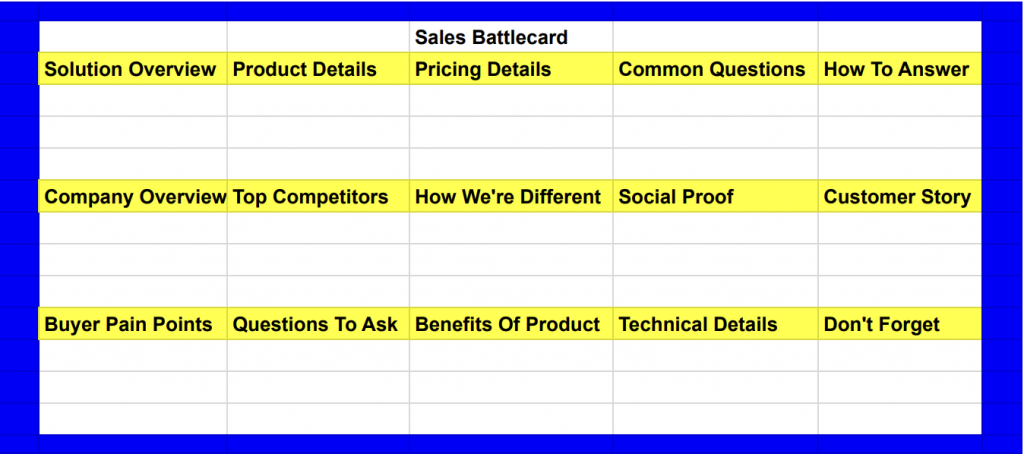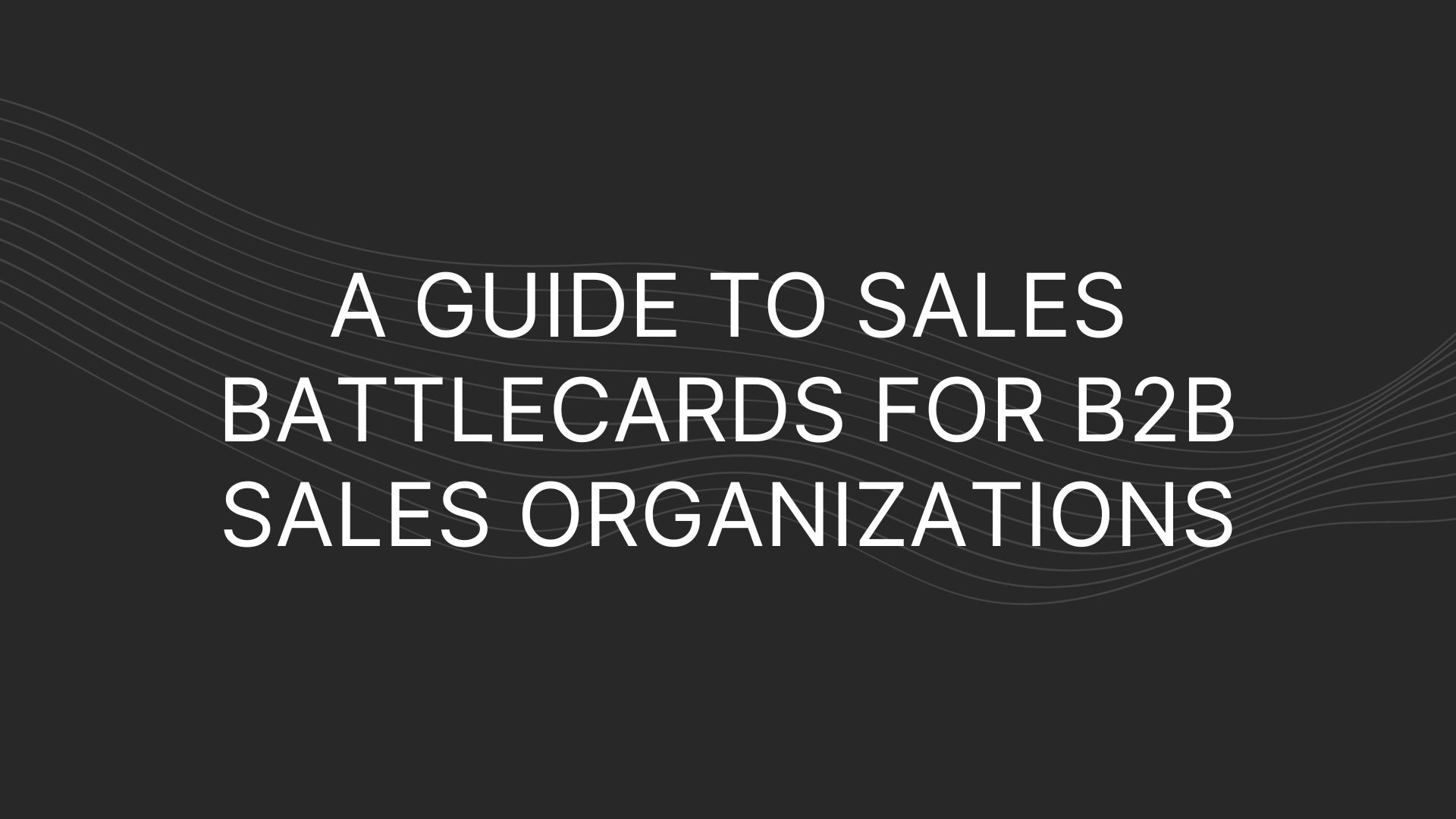Sales battlecards are crucial for businesses that want to have engaging conversations with clients. If salespeople aren’t engaging, unuable to handle objections or are flustered by not being able answer questions about how their company is different, it may mean lost sales. B2B sales is competitive with high buyer expectations. Sellers need to be prepared.
For a sales agent, a sales battlecard can:
- Create powerful, engaging conversations
- Push sales through quickly
- Improve overall sales close rates
If you’re not using battlecards yet, we’re going to outline what they entail, how they’re used, the types of cards available and more in the rest of our guide.
What is a Sales Battlecard?
Sales battlecards are documents, digital or physical, which can be used by inside and outside salespeople to hold important, meaningful conversations with clients and customers. Engagement and customer satisfaction are a major part of today’s business world.
Customers want to be seen as more than just a sale.
This is where battlecards can help. Battlecards are meant to drive sales, and they do because they contain:
- Product or service information
- Selling points
- Unique features
- Pricing
- Potential customer questions and responses
- So much more
Account Executives and Sales Development Representatives spend an average of 6 hours per week researching their prospects, and many of these prospects will not turn into paying customers. Meaningful conversations, with the help of sales battlecards, can change this.
In sales, every bit of information and prep work to make a sale can help a business make more money.
A sales battlecard will help sales teams arm themselves with information about a product or service to make more sales and respond to customers in an engaging, authoritative manner. These cards offer:
- The most important information
- Key responses and talking points
- Happier sales staff and consumers
If sales have been staying steady or increasing, it may be difficult to justify changing anything in your processes. However, there are many reasons why it may make sense to begin using battlecards for your sales development representatives and account executives..
Why Sales Battlecards Should Be Used
Sales help businesses stay in business and salespeople earning a commission. A rep can use a single battlecard or many to help do a few key essential things:
Pitch to Leads More Effectively
One pitch may work very well for one product or service and fail with another. If a salesperson doesn’t adjust their approach over time, it’s possible that their sales figures will fall.
Why?
An effective pitch isn’t being used to make the sale. Battlecards help teams get through:
- Periods where they have to rapidly gather information to hit on the lead’s pain points
- Rough periods where their pitches aren’t working to generate sales
- Pitch to specific types of clients more effectively
Sales team members may have rough patches where their sales dry up. A mental roadblock or even life issues can get in the way of making a compelling pitch.
Using one or more sales battlecard may be all that’s necessary to get the creative juices flowing again and help improve a sales pitch. As we’ll see in just a few sections, there are many types of B2B battle cards that can help sell your product or service more effectively.
Stay Informed of Industry and Competitor Changes
Businesses can and should keep sales battlecards updated to help improve salesperson knowledge. For example, a business may have salespeople:
- Joining the company who haven’t been in training yet
- Sales agents that are just coming back from time off
- Questions about competitors that salespeople should be prepared to answer
If a competitor’s product change was just promoted, a potential customer may ask how your product can compete with the new version from your competitor. Salespeople that hesitate to respond will see their sales figures drop if they don’t know how to answer.
The competition is always trying to stay ahead of your business and erode your market share.
Using a sales battlecard, especially when they’re routinely updated, can help these sales agents respond quickly. The card may outline how to respond to a specific question and may even go over the ways that your product or service are better than the competition.
Consumers want the best product or service to solve their business’s pain points. If your salespeople use the information on their battlecard effectively, it can help demonstrate how your business’s solution is an industry frontrunner. And provide a positive customer experience.
Change Pitch Based on Situational Changes
Pitches can seemingly fail in the middle of a discussion, but the right salesperson can adapt to these situations. The times when situational changes put a sale in jeopardy, situational information on the card can be helpful.
For example, it may be possible to change things up in a pitch by:
- Putting the use of the product into context to touch on pain points
- Pushing licensing or purchasing based on the downsides of the existing solution
- Alerting the consumer to new features or products that may help solve their problems in a new, more effective way
Cards can also help the sales team know how much leeway they have to offer discounts or alert them of new promotions that may convince a budget-conscious lead to make a purchase.
Sales battlecards can be used in dozens of other ways, too. For a sales team, a single card can mean the difference between a sale or a lost lead.
How Sales Teams Benefit from Sales Battlecards
It’s evident that sales teams can increase sales and conversions when they have the right information at their fingertips. Battlecards offer many benefits to sales teams, including but not limited to:
- Preparing sales teams to rapidly respond to the lead’s questions
- Alerting teams of key updates or changes to the product
- Discussing changes to competitor products and why your solution remains a top choice
- Provides a reference to pertinent information that may be forgotten when pushing a sale
Salespeople need to have a good day, every day. Life gets in the way of a 100% perfect sales record, and battlecards can help dramatically during these periods to recenter salespeople who may be having an off day. Having a go to resource that helps answer questions or provides guidance, can help salespeople overcome rough patches.
Sales Battlecard Best Practices
There are several tools out there to help you create sales battlecards. Logistics and design aside, there are some best practices that you should follow when making your battlecards.
Don’t Overload Your Cards
If you want your battlecards to be useful, make them short and sweet. Give your sales team battlecards that are easy to digest and skimmable. The easier it is to find the information they need, the more effective your battlecards will be.
Use Social Media to Gather Intel on the Competition
Users are talking about your competitors online. Use social media, forums and other online resources to gather intel on the competition and relevant insights you can use in your battlecards.
It’s important not to bad-mouth your competitors, but rather, use this information to highlight potential issues that you can solve in a tasteful way.
Make Success Stories the Star of the Show
Highlighting ways your product is better than the competition is helpful. However, this shouldn’t be a battle between your products and your competitors’ products.
Instead, make sure that your battlecards are focused on the success of your customers. Success stories demonstrate how your product can solve problems and help people achieve their goals.
- How will your product solve the prospect’s pain points?
- If you have a unique feature, how will it benefit the customer?
- What will your prospect be able to do in the future?
The focus should always be on why your features, pricing, etc. are important to the customer.
Make Your Sales Battlecards Accessible
Your sales team shouldn’t have to jump through hoops to access your sales battlecards. Make them easily accessible.
- If you use a sales platform, put your cards there.
- If you use a CRM platform, put your cards there.
- If you have sales tools they can integrate with, consider adding them there.
Keep Your Cards Updated
When possible, take advantage of integrations to keep your battlecards updated in real-time. Having the most up-to-date and accurate information is crucial to the success of your sales team.
If your battlecards have outdated information, it could damage your reputation.
There are many ways to use integrations with your battlecards. For example, you can integrate the tools you use for analyzing competitor pricing and intel to keep your cards updated in real-time.
Types of B2B Battle Cards
Multiple types of battle cards exist, and there’s no hard and fast rule on using just one type of card. Businesses often find it most effective to use multiple types of battlecards to help sales teams maximize their sales.
Depending on your team’s needs and market you sell into, a specific type of B2B battle card may be right for you.
Some of the many types of sales battlecards that may be used to convert buyers include:
Product Battle Cards
Product cards are an asset to every sales team. These cards are information-packed, and they explain to teams everything they need to know about the product and consumer. For example, one of these cards may have:
- Script to start off discussions
- Challenges the buyer is having
- Key information about the product or service being sold
- Comparisons with top competitors in the industry
Some cards may be very detailed and complex, too. These cards may provide use cases, or scenarios when the product will exceed expectations and more.
Competitor Battle Cards
Competitors want to make a sale just as bad as your team. Using a competitor card is a good way to sway sales in your team’s direction. These cards may include:
- Full list of competitor features and price options
- Drawbacks of the competing product
- Key benefits of using your business’s solution
- How your product is different
The competitor card arms sales experts with the information they need to have a deep, convincing conversation with leads to increase sales. Inside sales consults and fractional sales managers can help your team create these if your organization doesn’t have time.
Question Battle Cards
Buyers have many questions, and the question card will help sales teams reply to these questions appropriately. A few of the key questions that may be listed on the card are:
- Why are you considering moving to a new product or solution?
- What are some of the pain points your business is experiencing?
- What features do you wish that your current solution provided?
You can also go into more thought-provoking questions, such as, “What if you could reduce time spent on X task by 20%?” When question battlecards are used properly, they’re a powerful tool that can keep conversations going and sales flowing into the pipeline.
Case-based B2B Battle Cards
Case-based cards can help demonstrate how your product solves problems and helps customers succeed.
Include brief examples of use cases where your product or solution may help the customer achieve their goals.
- What features make your product useful in this particular use case example?
- How can your product solve pain points in this particular use case example?
Case-based cards help your sales team use real-world examples of how your product can be useful and add value to their lives.
Value Prop-based B2B Battle Cards
Value prop-based battlecards focus on the unique selling points of your product and the value it provides to the customer. These cards can include:
- Qualifying questions are unique for each decision-maker, including CEOs/VPs, managers, system administrators, etc.
- Data on target customers, including the top industries that use your product.
- Your value proposition. What benefits does your product offer? What makes it different from others?
- Why customers should choose your product.
Value prop-based cards should help your team convince prospects that your product will make their lives easier and solve their problems.
How To Make a Sales Battlecard
Sales battlecards help your sales team succeed. They can provide the necessary information at an inflection point during a sales conversation.
The key is to create sales battlecards with the right information and present them in a way that’s easy for your team to skim and digest.
What Should Sales Battlecards Include?
When creating battlecards, it’s essential to make them specific to your product. While you will also want to include some things that are unique to your business, there are some general things that should be on most sales battlecards, including:
Product Description
Your sales battlecard should start with an overview of your product, your company and your offering. Keep it short and straightforward.
Buyer Pain Points
Your sales team should be able to answer the question, “why should I buy your product?” with confidence, and knowing your buyer’s pain points can help.
Your customer’s pain points are the problems or “pains” that they’re seeking solutions for and that your product can solve.
Product Features
Battlecards should also include a rundown of your product features because it’s these features that will help solve your customer’s pain points.
You likely also have other features that will appeal to your customers and may solve other problems or benefit their lives in other ways.
In most cases, it will be your product’s features that will convince customers to take the dive and buy.
Unique Selling Points
You may have a great product and great features, but what makes you different from your competitors? If you’re just selling the same product as everyone else and at the same price, it may be hard to sway potential customers.
List your key differentiators to let customers know what makes your product the better solution.
For example, if you have a software product:
- Is it faster than competing solutions?
- Does your product have more features?
- Is your support team more responsive?
- Do you have better security or privacy protection measures?
Create a bullet list of features that are better than the competitors and why or how.
Objections and How to Respond
Your sales team will likely face objections when trying to sell your product. It’s crucial for them to have thoughtful responses prepared to keep the door open with the potential customer.
In this section of your sales battlecard, create a list of a few objections your team is likely to face and a response they can use to overcome this obstacle.
Pricing
Undoubtedly, your sales team will be asked about your pricing. Make sure your battlecard includes your pricing model and also how it compares to your competitors. Provide your sales team with as much information as possible about pricing so that they can answer questions with confidence.
Make sure that you’re researching your competitors regularly and updating your pricing comparison information. Doing so will ensure that your team always has the most updated and accurate information.
Questions
Sales battlecards should also include a few questions that your sales team can ask prospective buyers. These questions should help give your team a little more information about the customer’s wants and needs, so they can pitch the product appropriately.
For example, your team may ask:
- What frustrates you the most about your current solution?
Getting information about the individual’s unique pain points will help your team position your product as a better solution.
Social Proof
Testimonials and social proof can help build trust and credibility to make prospective customers feel more comfortable taking the next step.
If possible, refer to relevant customers to give your potential customers FOMO (fear of missing out).
Sales Battlecard Example

Template for B2B Sales Battlecards
We’ve created a template for battlecards that you can use and adjust to meet the needs of your sales team.
Use this link: Sales Battlecard Template
Sales battlecards are an asset to sales teams. If you want to improve conversations with buyers and improve sales conversions, the right sales battlecard can help.



